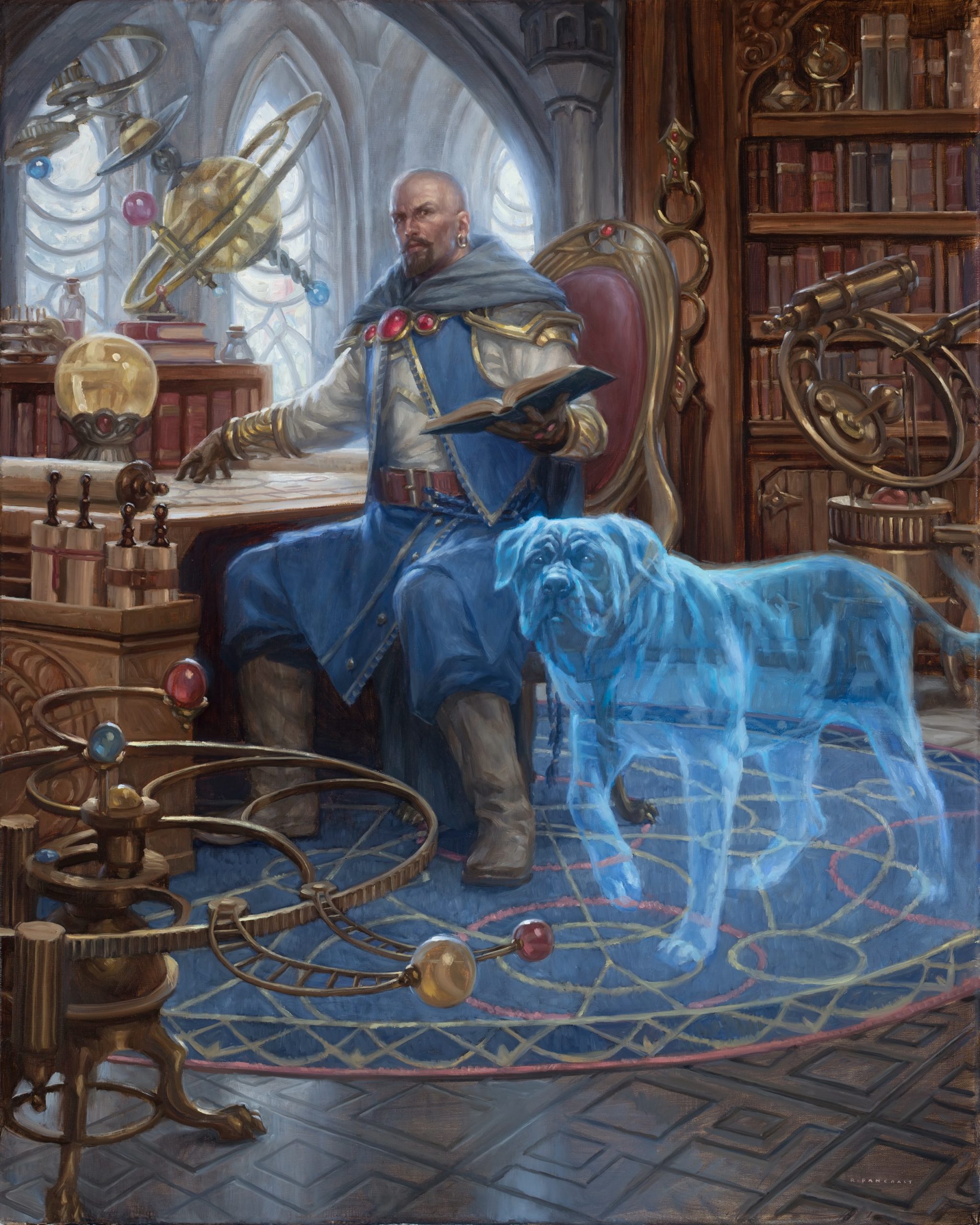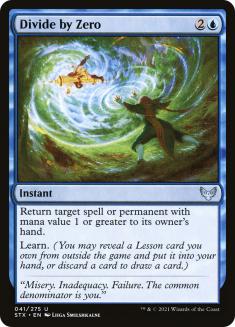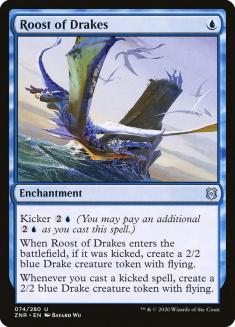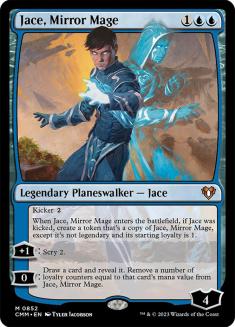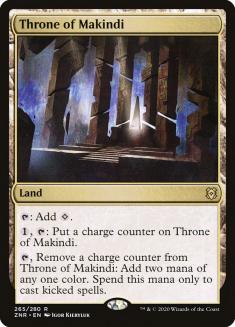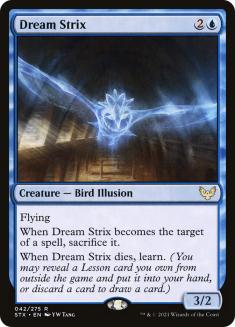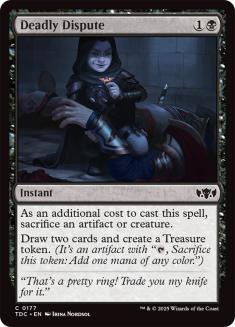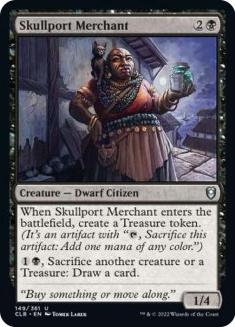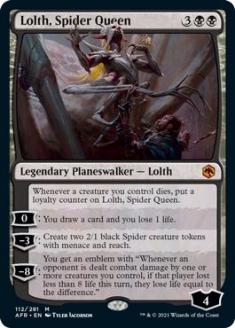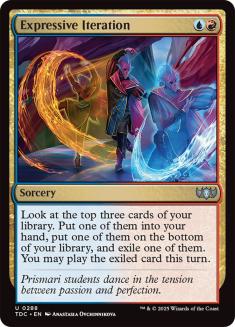I saw that Dimir Control has been doing well in Standard 2022, and I was intrigued. Behold the Multiverse and Saw It Coming form a pretty good core of the deck, black has good removal, there are good planeswalkers in both colors, and I’d always wanted Graven Lore to be good, so I wondered if this would be its chance to shine.
I queued it up on Magic Arena and it seemed I wasn’t the only one intrigued by Dimir. I played a lot of mirror matches where both of us clearly came from the same starting point. We both had more threats than answers, and we played games where it felt like the player with fewer cards in their library was the one who was forced to act and try to resolve a six-mana planeswalker through a wall of counterspells. Graven Lore didn’t feel great because the control mirror felt like where it should shine, but I didn’t really want more card draw, I wanted more threats or permission. It felt like I’d likely have an edge if I just added ten cards to my deck.
I didn’t really like that idea (okay, that’s a lie, but I still tried to find a different solution), so instead I replaced Negates with Test of Talents (I think if you ever exile two or more copies of Saw It Coming from their deck, you’re a huge favorite) and added a Demilich. Most Dimir decks have some Baleful Masteries, but most of their removal spells don’t exile it, so it felt like a reasonable way to make the deck function as if it had a few more threats. I haven’t drawn it yet in the mirror, but it was a good way to close a game out against Rakdos.
Playing against other decks in this format really highlighted the importance of having some kind of end-game rather than just relying on glorified Divinations, removal spells, and a few sweepers. Cards like Monk Class and Ranger Class offer persistent card advantage that Dimir can absolutely outclass, but you need some reasonable top-end or engine of your own to do that.
After tweaking a fairly standard Dimir list a bit, I landed here:
Creatures (2)
Planeswalkers (2)
Lands (25)
Spells (31)

I love the number of cards that I want to play small numbers of copies of. I actually started with fewer different spells in my deck, but found myself wanting variety. The removal spells all have really substantial strengths and weaknesses.
You want answers to planeswalkers? I have Bloodchief’s Thirst, Soul Shatter, Baleful Mastery, and Blood on the Snow. You want answers to creature lands, especially Hall of Storm Giants? I have Poison the Cup, Baleful Mastery, and sometimes Soul Shatter, but it can be awkward that it doesn’t hit a land if they control a token. Soul Shatter is great against Goldspan Dragon and for bypassing ward. Flunk is cheap and versatile, but misses some things. Exiling can be important, but isn’t often, but I have Baleful Mastery and Shadows’ Verdict to do it. There are just a lot of different jobs that need different tools, but you don’t want the tools to be too narrow.
I’ve liked having a mix of threats, but I’ve been more impressed with Modenkainen than Professor Onyx overall, albeit not so much that I want a 2-0 split, I think.
I didn’t have Divide by Zero initially, but playing against it in a control mirror I was impressed by its ability to save a card and find another impactful threat like Mascot Exhibition or Confront the Past. It certainly wouldn’t be worth the sideboard space in Best-of-Three, but when there’s no cost in Best-of-One, I think I like it.
Really, when playing this deck, especially in mirrors, I mostly find myself wanting to be a little more proactive. I didn’t like that all my threats cost tons of mana and then just got answered. It felt like there should be another way. Maybe I’m just not built right for true control and I need to play something more like Faeries.
So I leaned on my experiences in the Limited formats of Standard 2022 and came up with some approaches that I thought might do a better job of getting an advantage in the control mirror.
First up, kicker. Playing against Ranger Class is scary because it’s very hard to answer. You basically just have to kill their creatures and then do something powerful before they run you out of removal by playing off the top of their deck. Roost of Drakes is similarly awkward for Dimir to answer, so I wondered if I could lean into that.
Creatures (4)
Planeswalkers (2)
Lands (24)
Spells (30)

This deck still has the Saw It Coming / Behold the Multiverse / Poison the Cup backbone, but also supports enough of a kicker theme to power Roost of Drakes.
One card that stood out with this strategy is Jace, Mirror Mage, which played pretty well independently of kicker synergies. When you kick it, it really feels like you get five mana worth of planeswalker, but it doesn’t die to a single removal spell, which is really nice.
I’m leaning on Crippling Fear and not Shadows’ Verdict because I like that it can leave all my Drakes alive, but I’m not sure that that means it’s right not to include Shadows’ Verdict.
Playing more Bloodchief’s Thirsts and Bubble Snares cuts into my instant-speed removal, which is particularly painful against creature-lands, but the additional battlefield presence gained from Roost of Drakes makes those slightly less threatening overall, and there are still six instant-speed removal spells in the deck that can potentially hit lands.
The correct number of copies of Throne of Makindi is a tricky question. Getting an extra mana out of a land is great, but this deck is really mana-hungry, so it’s hard to find a chance to put a counter on it. I played four and that was definitely too many if you’re not trying to play any expensive kicker cards, so I’m down to three, but it still might be more than I want. I’m also not totally sure that it’s better not to play Inscription of Insight or Inscription of Ruin, but they booth seem a little too expensive.
I could also see a version of this deck that’s a little more proactive that uses cards like Check for Traps and Sea Gate Stormcaller, possibly with Village Rites or Deadly Dispute, and maybe even Coralhelm Chronicler, but that stuff just seemed a little too weak. I think I like roughly where I ended up for of number of kicker cards.
I’m not totally sold on Thieving Skydiver. There are a few things to steal, but not many. It could easily be better off as more Skyclave Shades or Jace, Mirror Mages. Skyclave Shade is awesome in control mirrors, but a bit of a liability if the opponent is aggressive.
When I added Divide by Zero to the first control deck, I thought that what I really wanted might be Dream Strix. It’s a low-investment threat that puts me a up a card that I could cast pretty safely in the mirror, and it’s probably a reasonable enough blocker against other people. I didn’t really know how to make space for it, so instead I just built a new deck around it.
Creatures (10)
Planeswalkers (3)
Lands (24)
Spells (23)

Deadly Dispute is an incredible card in a control deck. Instant-speed Divination for two mana is basically the exact card control has always dreamed of, and Treasures are the perfect reserve to always keep a counter up. Dream Strix was a great step toward allowing me to play Deadly Dispute, but Eyetwitch is even better.
I started by trying to support these with Sedgemoor Witch, but my opponents kept killing them and I couldn’t really punish them for paying the three life. I hated that I was giving them a one-for-one exchange with my three-mana card, and I realized I wanted Skullport Merchant instead, because it leaves me up an important resource. With Eyetwitch, Dream Strix, access to Pest Summoning, and Deadly Disputes to make Treasures, Skullport Merchant threatened to draw cards frequently enough that my opponent wouldn’t really want to ignore it.
With all these creatures and a sacrifice engine, I was positioned to take advantage of Lolth, Spider Queen, which I had success with in Golgari but hadn’t loved in Dimir.
I noticed when an opponent cast Expressive Iteration how jealous I was, but I realized that since I’m making a few Treasures anyway, I could play Pathways and it would be really easy to splash it. You might think I had enough two-mana Divinations with Deadly Dispute and Behold the Multiverse, but I’m not really sure what it means to have “enough” two-mana Divinations when more are available.
This deck doesn’t have as many removal spells, with only three Poison the Cups and two Soul Shatters, but with so much card selection, it plays like a bit more than that. It’s definitely more proactive, but that’s my goal — to get a little leaner and more proactive without giving up the ability to grind with card draw, removal, and planeswalkers.
So far, I’ve liked how it does that. I could see playing a big finisher like Alrund’s Epiphany or Magma Opus to take advantage of all the Treasures and the fact that all the card draw means I keep hitting my land drops, but so far I’ve been happy to just have the smoother curve. It makes the deck play more like a Modern or Legacy deck.
When I looked at results, the Dimir Control decks seemed remarkably similar given how many different tools are available. While playing these, I also ran into Dimir Snow, which used Ascendant Spirit and Frost Augur to go under and Narfi to grind, so I’m not the only one trying to find a way to apply earlier pressure in the Dimir mirror.
While I respect the pure control strategy, I always prefer games where I can pester my opponent with some cheap flyer to force them to act rather than one that’s just about Dragons and planeswalkers.

